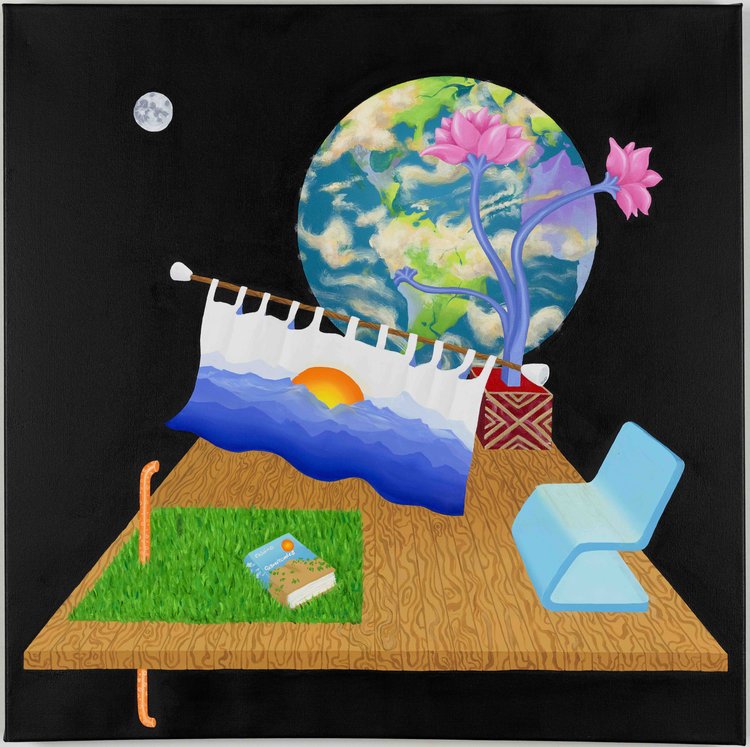Blood Clock 2020
2020-2022
January, February, March, and April
Acrylic on Canvas
2020-2021
36”x30”; 20”x30”, 20”x30”, and 36”x30”
May, June, July, and August
Acrylic on Canvas
2021
36”x30”; 20”x30”, 20”x30”, and 36”x30”
September, October, November, and December
Acrylic on Canvas
2022
36”x30”; 20”x30”, 20”x30”, and 36”x30”
These paintings, along with 12 watercolor paintings, are exhibited at Catalyst Contemporary in Baltimore, MD through May 27th, 2023. The show also features sculptures and photographs by Bonnie Crawford.
Blood Clock 2020: Challenging Culturally Mandated Acts of Feminine Discretion
(This essay is featured in Hopkins Review Issue 16.2 along with cover art and inside portfolio)
When I read the description of, and the public reaction to, Pipilotti Rist’s Blutclip (1993) in “The Colorful Worlds of Pipilotti Rist” (Calvin Tomkins’s 2020 profile of the artist in The New Yorker), I recalled how I felt ashamed about my menstruation for a long time while growing up in South Korea and in the US. It occurred to me that this sense of shame must have sprung from culturally mandated acts of feminine discretion: hide your tampon when you are going to the bathroom, erase all traces of blood in the toilet, and don’t talk about your period lest you make people feel uncomfortable. Rist created Blutclip—Blood Clip, in English—one year after a positive reception of Pickelporno, her response to the discussion around pornography and feminism in the 90s. Filmed with a tiny surveillance camera, Pickelporno exposes glimpses of foreplay, interspersed with shots of lush natural imagery and other human body parts, including “an erect and friendly penis.” Despite the explicit sexual candor, Pickelporno, according to Tompkins, “offended no one—it even aired on Swiss television.” But Blood Clip’s depiction of menstrual blood, intended (in Rist’s words) “to get the blood out into the open” and showcase this “marvelous liquid, this flesh-clock,” did cause offense, seen by some as “taking feminism too far.”
What does it mean to take feminism too far? Menstrual taboos and stereotypes are still ingrained in contemporary social structures, impacted by religion, nationality, politics, economics, ethnicity, class, gender identity, and many other sociocultural factors. “Taking feminism too far” by getting “the blood out into the open” means challenging the strictures that mandate acts of feminine discretion, that necessitate economic burden on women for feminine hygiene, that equate femininity with neuroticism, and that align fertility with control. Inspired by Rist, I also wanted to get the blood out into the open, because the contemporary social structure needs to be challenged as a prerequisite for moving toward an equitable future. To get the blood out into the open, I made twelve paintings documenting my menstrual cycle: one for each month of the year 2020 when our collective sense of time had been distorted by the global pandemic. This body of work is titled Blood Clock 2020 as it is my response to Blood Clip to showcase my own “marvelous liquid, this flesh-clock.”
Susan Sontag in Against Interpretation observed that works of art “give rise not to conceptual knowledge but to something like an excitation, a phenomenon of commitment, judgment in a state of thralldom or captivation.” With Blood Clock 2020, I intend to captivate the audience in a contemplation of the red liquid without turning away with a sense of shame or disgust that is often associated with menstrual blood. Instead, I wanted to celebrate menstrual blood as the medium for human existence that nourishes our culture and gives birth to new lives. To foster a consideration of the human existence and temporal scales within the context of the larger world, I suspended the blood droplets against lush landscapes, ranging from desert plains to aquatic and mountainous environments. I integrated imagery from paintings by Georgia O’Keeffe, who masterfully painted flowery vaginal images without stirring any sense of shame nor perverting the subject. I wanted to simulate a dialogue with and learn from O’Keeffe, who famously stated, “I had to create an equivalent for what I felt about what I was looking at—not copy it.” Accordingly, I integrated what I felt about O’Keeffe’s paintings Deer’s Skull with Pedernal (1936), Summer Days (1936), Lake George (1922) and Lake George Reflection (1921–1922), Pedernal (1945), and Black Palace II (1945) into my menstrual cycle paintings, to give rise to a new life through the synthesis of my creative desire and expression with those of O’Keefe’s and Rist’s. I also chose to depict the menstrual blood like hot wax dancing in a lava lamp. The undulation of blood droplets, like those of hot wax seamlessly and ceaselessly rising, merging, and reshaping, are meant to mesmerize and transport the audience in “a state of thralldom.” By getting the blood out into the open with these paintings, I invite the audience to challenge the culturally mandated strictures, such as menstrual taboos and gender essentialism, that constrain our imaginations as well as livelihoods.
Se Jong Cho
April 2022




















